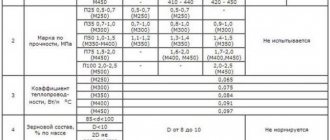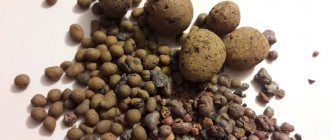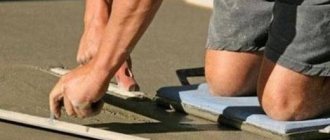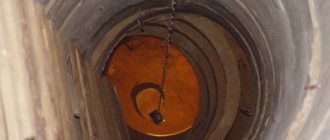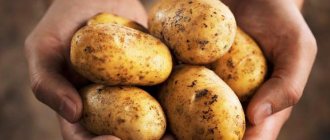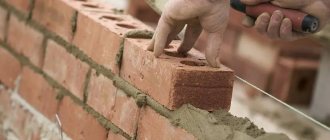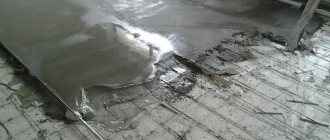Expanded clay as a multifunctional material is common in various fields of construction. Its main advantage is a high degree of sound and heat insulation. Therefore, it is often used as insulation. Expanded clay is widely used in agriculture and manufacturing. There are several types of material and packaging. How to choose and calculate the required quantity, what is better: expanded clay in bags or in bulk? This article contains answers to these questions.
Expanded clay is a multifunctional material widely used in construction, landscape design and agricultural work.
How much does 1 cube of expanded clay cost?
Prices for expanded clay
| Fraction | Volume | Price |
| Expanded clay in bulk Fraction 5-10 mm | 1 m³ | 1,700 rub. |
| Expanded clay in bulk Fraction 10-20 mm | 1 m³ | 1,200 rub. |
| Expanded clay in bulk Fraction 10-20 mm | 1 m³ | 1,650 rub. |
| Expanded clay in bulk Fraction 10-20 mm | 1 m³ | 1,900 rub. |
How to make cement laitance for pouring expanded clay. Application of cement laitance in construction
Cement laitance is a liquid layer of concrete, the appearance of which stops the vibration of the solution. If it continues, delamination of the concrete mass may begin. Cement laitance, which forms naturally on the surface of a concrete product, has only disadvantages. If the mixture is prepared for certain types of work, it has many positive qualities. Cement laitance has the following advantages:
- strength;
- good sound insulation;
- water resistance;
- thermal insulation properties;
- the mixture hardens quickly.
There are no regulatory documents regarding the composition of cement laitance. The practice of using milk during construction work has shown that 3-4 times more water is consumed to prepare the mixture than cement. The prepared solution is used to repair cracks on the concrete surface. Many people ask the question: what is cement laitance?
Cement laitance is a mixture consisting of water and cement, having the consistency of sour cream. To give it a lighter shade, a certain amount of slaked lime can be added to the solution.
This mixture is used to strengthen and protect the external plastered surfaces of buildings from precipitation. Concrete is ironed with a solution of cement in water to give it additional strength. The solution is applied in a thin layer to the inner walls of metal barrels to protect them from corrosion.
Building houses is impossible without building a foundation. The foundation for a small private house can be constructed from slag or expanded clay. To do this, you need to dig a trench, assemble the formwork and pour granulated slag or expanded clay into it. After completing the work, you need to fill the contents with a solution of cement and water. The milk consists of 2 parts pure water and 1 part Portland cement. Expanded clay should be poured in such a way that a protective layer of cement laitance about 2 cm thick forms on top of the backfill.
Expanded clay is used for thermal insulation of ceilings and floors. This porous substance reduces the consumption of mortars. If the expanded clay layer is spilled with a mixture of cement and water, the granules stick together and the thermal insulation does not delaminate.
Before starting a concrete pumping line, the inside of the hoses is often treated with cement laitance. After treatment, they are not clogged with working mortars.
How much does a kg of expanded clay cost?
Price per bag of expanded clay
50
kg
of fraction 20-40 costs from 80 rubles.
Interesting materials:
How and when to replant a pine tree? How do they find where to dig a well? How to fix if the laminate is swollen? How can you make fire if you don’t have matches and a lighter? How can you extract phone numbers from a phone if it is broken? How can you drain fuel if Glonass is installed? How to find the length of an arc if the radius is known? How to inflate a mattress if there is no pump? How to determine which side to lay the vapor barrier on? How to determine what voltage an LED strip is for?
Using bags for floor insulation
When insulating a floor, it is important to understand that the lower the bulk density of the material, the smaller its layer is needed. So, if you purchased expanded clay of grade 250, then a layer of 25–30 cm will be sufficient for thermal insulation. Of grade 450, the insulation layer should be at least 40 cm - the greater the weight, the fewer pores in the structure of the granules, and the worse their thermal insulation qualities .
Expanded clay grade 250 for floor insulation
When insulating the floor, a layer of at least 10 cm is poured - otherwise the desired effect will not be achieved.
Applying a 10 cm layer of insulation
If the material is packaged in bags, then it is laid on a previously prepared base. The bags are tightly fitted to each other and pierced in several places with a knife or screwdriver to release excess air. The thickness of the packaged material is 15–17 cm, so another ten centimeters are added on top, carefully leveled and compacted. A traditional screed is made on top of this pillow.
What is the volume in a ton of expanded clay?
If 1 cube has a mass of 200-400 kg, then 1 ton of expanded clay
There are approximately 2.5 to 5 cubic meters present.
Interesting materials:
How can you stick foil to glass? How can you privatize leased land? How can you spend an evening with a man? How can you spend time together? How can you spend a weekend with your loved one? How can you dissolve super glue? How can you divide a room into two? How can you breed anthurium? How can you sand a board? How can you solder the film?
How much does Expanded clay cost in Ukraine?
Expanded clay price in Kyiv - catalog of 12 products
| Expanded clay | Price | Availability: |
| clay packed 10-20 mm mesh (0.03 m3) | 74.32 UAH. | In stock |
| clay packed 10-20 mm mesh (0.04 m3) | 74.49 UAH | In stock |
| clay 10-20 mm bulk (m3) | 1260.00 UAH. | In stock |
| clay packed 10-20 mm mesh (0.05 m3) | 89.28 UAH | In stock |
How many liters are in a regular bag?
For example, bags with a volume of 30 to 60 liters
.
Typically, parameters are selected based on additional containers or fasteners used to secure the bag
in the open position.
In public institutions, larger volume products are used - up to 90 liters
.
Interesting materials:
What is soap scum? What is the initial phase? What is Novalon filler? What is voltage and current in simple words? What is HDMI CEC setting? What are True Wireless headphones? What is standard load? What is one square centimeter? What is fire clay? What is ondulin?
Expanded clay in bags: features and positive qualities of the material
Expanded clay has long been used in various areas of production due to a number of its positive qualities. This is a lightweight, natural and environmentally friendly material that is made from clay. It is practical to use and provides a high degree of noise insulation and heat conservation in rooms. The thermal conductivity coefficient of the material is quite low - 0.1-0.18 W/m K.
The advantages of expanded clay include its high thermal insulation properties, as well as resistance to fungi and mold.
Additional advantages of expanded clay are its relative moisture resistance, frost and fire resistance, as well as biostability. Fungus does not form in it and rodents do not breed. Correctly selected proportions, quantities and adherence to laying technology guarantee the reliability of the expanded clay screed and its long service life.
In large quantities, expanded clay is used as drainage on roads, to create sidewalks and embankments in the garden. It's quite easy to work with. However, before you buy expanded clay in bags or in bulk, you need to correctly calculate the required amount of material.
Expanded clay granules have different shapes. They are obtained from special types of clay, characterized by a high degree of swelling at high temperatures. Thanks to these qualities, pores appear, which provide the thermal insulation properties of the material.
Packaged expanded clay in bags is a higher quality and purified material
Expanded clay is produced in bulk and in bags in three types. Sand has granules up to 5 mm in diameter. Gravel has a more rounded shape, and the grain size reaches 20 mm. Crushed stone is a more angular material, its fraction is 20-40 mm.
Expanded clay density and material grade
Expanded clay is lightweight, and the density of the material determines its quality and area of use. It is this value that affects its quantity per cubic meter and, consequently, the weight of the expanded clay bag. This indicator depends on the fraction: the larger the granules, the lower the density of the material.
Helpful advice! When purchasing expanded clay, you must take into account the bulk density, which indicates the grade of the material.
The quality of expanded clay is determined by its bulk density index and manufacturing method
Production technology affects the density of the material. There are four ways to obtain this material:
- Dry. The simplest technology applied to homogeneous types of clay without impurities. Humidity does not exceed 9%.
- Wet.
- Plastic. The most common method. Granules are formed from wet clay and sent to the oven. The humidity of the raw materials reaches 30%.
- Powder-plastic. It is similar to the previous method, but the basis is dry clay, which is crushed, and then moistened and subjected to temperature influences.
It is the bulk density that is the brand of expanded clay. It is designated by the letter M with the corresponding number. For example, M300 means that 1 cube of expanded clay weighs from 251 to 300 kg. The lower the grade, the higher the thermal insulation properties. This material is best suited for insulating ceilings and floors.
In construction, expanded clay is most often used to insulate floors, walls and ceilings.
Expanded clay of a lower grade (fractions 20-40) is used as a heat insulator in foundations and basements. It is widely used for landscape design. Material with a minimum density is used to insulate walls, communications and facades. The finest expanded clay (with a fraction of up to 10 mm) is used in the preparation of expanded clay concrete for pouring floors.
Specific density and specific gravity of expanded clay
The density of expanded clay is measured using the bulk method, as well as by calculating its volumetric weight. This characteristic indicates the true weight of sand, crushed stone or gravel - without taking into account the space in the middle of the expanded clay granules. This feature underlies the difference between bulk and true density, which almost always differ from each other. True density is a constant indicator; it can only be measured in special laboratories. The specific gravity varies depending on the grain fraction.
The table clearly shows how much a cube of expanded clay weighs:
| Type of expanded clay | Granule fraction, mm | Specific gravity of the material, g/cm3 |
| Sand | 0,1-5 | 0,55-0,6 |
| fine gravel | 6-10 | 0,4-0,55 |
| Coarse gravel | 10-20 | 0,35-0,4 |
| Crushed stone | 20-40 | 0,2-0,35 |
The weight of sand can reach 600 kg per cubic meter, fine gravel - 450 kg, coarse gravel - 400 kg. A cube of crushed stone will weigh at least 350 kg. The higher the density of expanded clay, the greater the weight of the material. These indicators are regulated by the existing GOST.
The exact specific gravity of expanded clay is difficult to determine; you can only establish the average value, which is 400 kg/m³ (0.4 g/cm³). This indicator is influenced primarily by the size of the fraction. For example, a bag of expanded clay with a volume of one cube and a fraction of 10-20 weighs approximately 16.7 kg.
How many cubes are in a bag of expanded clay: calculating the volume of material
In order for the purchase of material to be truly profitable and economical, it is necessary to correctly calculate the required amount of expanded clay. As mentioned above, weight and volume depend on the density and fraction of granules. The most common packaging of expanded clay is 50 liters, which is a ratio of 0.05 m3. It turns out that the price of expanded clay per cubic meter is equal to the cost of 20 bags of medium fraction material.
You can calculate the required quantity and calculate how much a cube of expanded clay costs based on the following parameters:
| Bag volume, l | Number of bags per cube | Bag volume, m3 |
| 50 | 20 | 0,05 |
| 40 | 25 | 0,04 |
| 25 | 40 | 0,025 |
Different types of work require different amounts of material. For example, for a wet screed you will need part cement, 3 parts sand and 4 parts expanded clay. This means that 30 kg of concrete will require 25 kg of expanded clay. Next, the total quantity is determined. For effective insulation, the screed layer must be at least 10 cm. This parameter is multiplied by the area of the room and divided by the volume of one bag.
An approximate calculation for a room of 20 square meters will look like this: 20 m² x 0.1 m/0.05 m³ = 40 bags. Thus, the total price of expanded clay for the floor will be equal to the cost of 40 bags of material of the corresponding fraction.
Thus, when choosing expanded clay as insulation, you should trust well-established manufacturers and their distributors in the construction market. If we are talking about large volumes, then it is better to purchase the material in bulk. However, during long-term transportation and the absence of storage conditions, it is recommended to give preference to expanded clay gravel or crushed stone in bags. If you have doubts about your own abilities, it is better to entrust the entire process to experienced specialists.
How much does expanded clay cost: what does the price of the material depend on?
The network of construction supermarkets offers a wide range of expanded clay. The product can be purchased both in bags and in bulk. In the absence of appropriate storage conditions for bulk material, it is better to choose packaged products.
Helpful advice! When buying expanded clay, you should take into account that small granules have lower thermal conductivity, while having the highest bulk density.
The size of expanded clay granules (fraction) affects the market value of the material
Packaging facilitates easy transportation, shipment and warehousing for storage. During transportation, the material does not crumble, and its use will be waste-free.
The packaged substance is purer and does not have foreign inclusions. You need to know that the cost of expanded clay per cube is slightly cheaper than in bags. But if you plan to purchase several cubes in bulk, then it is more profitable to purchase expanded clay in bags with delivery.
The cost of the material, which is formed by the manufacturer, is influenced by the quality of raw materials, production methods, storage conditions and transportation costs. Of considerable importance are production capacity and volumes of products, energy costs, labor resources and overall turnover in the market.
Expanded clay in bulk will cost less than packaged in bags
How much does a bag of expanded clay cost: factors that form the retail price
There are many other factors to consider that determine how much bagged expanded clay costs. The price is formed based on the following components:
- expanded clay fraction. The main nuance is this: the smaller the granule size, the more expensive the bag will be. This depends on the weight and density relationships described above. It should be noted that the costs of sand are much higher than, for example, gravel or crushed stone;
- the presence and size of pores in the material. The thermal insulation qualities of expanded clay depend on porosity, that is, on the number of cells in the granule fracture. Accordingly, this factor directly affects price formation;
- method of packing the material. Paper bags in several layers provide good protection of goods from dirt and moisture. In addition, in this form it is easier to load, transport, store and record products;
- packaging. The process of material distribution is a special, separate production cycle that requires additional labor and space. For this purpose, special equipment is purchased in the form of dispensers, special scales and a bulk bunker;
- weight of a bag of expanded clay. The cost is also affected by the number of kilograms of expanded clay in the bag. Packing 25 kg will cost more than 50 kg bags of the same material;
Expanded clay of a fine fraction is usually used for screeds in the composition of the solution
- total purchase volume. Large quantities with a significant number of bags will cost less. Most suppliers immediately offer wholesale and retail prices;
- payment method. Sometimes sellers offer special discounts on the purchase of material for cash (or if non-cash payments are made through partner banks).
Expanded clay price in bags and per cube: comparison table
The cost of expanded clay is affected by specific density. In addition, the price of the material depends on the manufacturer. The denser the expanded clay, the more expensive it is. A component of the price is also the volume of purchased raw materials. If we are talking about large quantities, then it is better to buy expanded clay in bulk. The price will be several times lower. There is also a difference in the packaging of expanded clay: the price for a 50 kg bag will differ from the cost of a 25 kg bag.
Helpful advice! Its functionality depends on the weight of 1 m³ of expanded clay filler. The smaller it is, the higher the thermal conductivity effect, that is, it will conduct more heat, having a lower degree of thermal protection.
The cost of expanded clay per bag and in bulk may vary slightly. This is evidenced by a table compiled based on the amount of material required.
Average prices for expanded clay:
| Type of expanded clay | Granule fraction, mm | Price for 1 bag weighing 50 kg/rub. | Expanded clay price per 1 m3 with delivery |
| Sand | 0-5 | 100-140 | 1900-2100 |
| fine gravel | 5-10 | 90-120 | 1800-2000 |
| Coarse gravel | 10-20 | 70-110 | 1650-1900 |
| Crushed stone | 20-40 | 60-85 | 1500-1600 |
The largest price range for a cube of expanded clay and packaged material is observed in relation to gravel with a fraction of 10-20, since this raw material is the most popular. It is made by many manufacturers from various materials with different densities. Due to the versatility of the raw material, it is used in the insulation of various structures. This expanded clay is quite light and reduces heat loss by an average of 70%.
Price of expanded clay blocks and its components
In order to quickly build warm walls, expanded clay blocks are often used. Their types depend on their purpose: for external walls, partitions, for additional insulation. Expanded clay concrete blocks differ from pure expanded clay in that they contain admixtures of cement and sand. They are a monolithic product. The composition and dimensions are regulated by GOST 6133-99. When ordering material for different purposes, you should take into account the width and thickness of the blocks.
In accordance with the application, the parameters of expanded clay blocks are selected, which can have dimensions of 39x18x19 cm or 40x20x20 cm. Walls made of expanded clay concrete, provided the correct choice of material, can last over 50 years. The material for partitions is characterized by parameters of 39x9x19 cm. Another name for the product is semi-block. Sometimes blocks serve as the foundation in the construction of wooden houses.
Expanded clay blocks are lighter in weight compared to other materials
The cost of the material depends on its type, shape, as well as composition and impurities. It is cheaper to purchase blocks from the manufacturer than from resellers. Intermediaries also regulate prices in different regions. The cost of a standard block at the factory is on average 36 rubles - and 20 rubles for a half-block. The markup from resellers reaches 15-18 rubles per piece.
When purchasing expanded clay blocks, you need to find out such a nuance as delivery. You should clarify whether suppliers provide it or whether you need to organize removal yourself. It is important to take into account the number of blocks purchased, since some factories produce material only in large quantities. Therefore, if you need a small amount of material, you will have to use the services of resellers.
Helpful advice! Not only the efficiency of the building and its strength, but also the total cost of materials depends on the correct choice of blocks.
A building made of expanded clay blocks will have excellent thermal insulation
Where to buy expanded clay in bags and how to save on delivery
The most profitable option for purchasing expanded clay is directly from the manufacturer. Eliminating intermediaries from the trade chain allows you to save up to 25% per bag of material. This is due to the fact that organizations involved in sales include in the price the costs of transportation, storage, payment for rent of premises, labor of loaders and sales agents, etc. In addition, resellers of products make a markup taking into account economic risks.
In Russia there are many plants for the production of expanded clay, the most popular among them are Meliz LLC in Kursk, Aleksinsky expanded clay located in Serpukhov. It is also worth mentioning the Azarovsky Wall Materials Plant in Kaluga and JSC Experiment in Kostroma.
Buying larger bags is much more profitable. For example, a kilogram of expanded clay with a fraction of 5-10 mm in small (kilogram) packaging will cost 6-8 rubles, and the price in a container weighing 50 kg is only 2 rubles.
Expanded clay packed in bags is more convenient to transport
A separate expense item is the delivery of materials. The further away the point of sale, the more expensive the transportation. If you intend to purchase small volumes of coarse gravel, then it is better to transport the bags in your own passenger transport. If you need to buy expanded clay 0.5 in 50 kg bags in large volumes, then taking it out yourself will be quite expensive. After all, to do this you need to find a special, spacious vehicle and pay for its operation. In this case, it is more profitable to deal with a seller who provides cargo delivery services.
If the insulation is carried out by a construction organization, it is recommended to entrust the purchase of all building materials, including expanded clay, to professionals. Specialists, as a rule, have established mutually beneficial relationships with suppliers, and they also have discounts as regular customers.
Where to buy expanded clay on favorable terms
One of the options for a profitable purchase of insulation can be the purchase of used material. Recycled expanded clay can be purchased from companies that dismantle old buildings and remove construction waste. The price of a cube of used expanded clay can be half that of purchasing the material from the manufacturer.
Due to their porous structure, expanded clay granules are very light in weight and therefore do not increase the overall weight of the building
When purchasing recyclable materials, you should pay attention to their condition. Crushed stone of large fractions must be sorted to exclude debris and crushed particles. Therefore, it is better to give preference to expanded clay, which served for some time as insulation on the roof. This material was not susceptible to excessive mechanical and atmospheric influences, so even after long-term use it is well preserved. Recycled expanded clay is suitable for pouring foundations or for thermal insulation of ceilings.
Helpful advice! You can save a significant amount of money by ordering material in bulk. Therefore, before starting construction work, it is advisable to calculate the total amount of insulation for the entire building.
If you decide to purchase on your own, you must first monitor product prices, study additional conditions and possible discounts at different retail outlets. In such matters, advice from friends and recommendations on the Internet will be useful.
If you need to reduce purchasing costs, you can purchase used material - expanded clay perfectly retains its properties
The seasonal factor should also be taken into account. So, in spring and summer there is a period of active construction - and prices for materials increase. Therefore, it is better to buy expanded clay in bags in advance, in autumn or winter. The price will be a quarter cheaper, and the packaged material is well stored.
How much does small expanded clay cost?
| Name of product | Packing | Small wholesale (from 0.5 cubic meters) |
| Expanded clay in bags, fraction 0-5 (Dry backfill) | Bag 0.05 cubic meters | 150 rub. per bag |
| Expanded clay in bags, fraction 5-10 | Bag 0.05 cubic meters | 115 rub. per bag |
| Expanded clay in bags fraction 10-20 | Bag 0.05 cubic meters | 84 rub. per bag |
| Expanded clay in bags, fraction 20-40 | Bag 0.05 cubic meters | 82 rub. per bag |
How much does 1 m3 of expanded clay 10 20 weigh?
How much does a cube of expanded clay weigh?
| Name | Size, mm | Volumetric weight, kg/cub.m |
| Sand | 0-5 | 600 |
| Gravel | 5-10 | 450 |
| 10-20 | 400 | |
| 20-40 | 350 |
Interesting materials:
How long should payment orders be kept? How many years have Kuplins been on YouTube? How old is Magomedsharipov? How old is Miran in the series? How old is Mr. Max Miss Katy? How old is the cartoon about Winnie the Pooh? How old is Sviridova’s husband? How many years do you have to be in the army? How many years do you have to live before your silver wedding? How many years ago did sugar appear?
